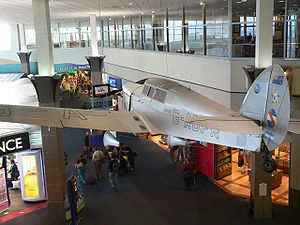Percival Gull
| Percival Gull | |
|---|---|
 |
|
| Jean Batten's Percival D.3 Gull Six on display at Auckland Airport | |
| Role | Three-seat touring and racing aircraft |
| National origin | United Kingdom |
| Manufacturer | Percival Aircraft Company |
| Designer | Edgar Percival |
| First flight | c. March 1932 |
| Produced | 1932-1938 |
| Number built | 48 |
| Variants | Percival Vega Gull |
The Percival Gull was a British single-engined monoplane, first flown in 1932. It was successful as a fast company transport, racing aircraft and long-range record breaker. It was developed into the Vega Gull and the Proctor.
The Percival Gull was the first aircraft of the Percival Aircraft Company, formed in 1932 by Edgar Percival and Lt. Cdr E.B.W. Leake. It was designed by Percival himself, and was strongly influenced by the Hendy 302, designed by Basil "Hendy" Henderson, that he had previously owned and raced. The new company did not have the facilities to build the Gull, so the prototype was produced by the British Aircraft Company of Maidstone, Kent, and the first 24 production machines were manufactured by Parnall Aircraft of Yate, Gloucestershire. In 1934, the Percival Aircraft Company moved to Gravesend Airport, Kent, where it built its own Gulls.
The Gull was a low-wing cantilever monoplane, constructed of wood with fabric covering. The wings reduced outwards in both thickness and chord, with dihedral outboard of the centre section. They were constructed according to Basil Henderson's patent, and folded rearwards at the rear spar for storage. There were split flaps inboard. The fin and rudder were initially very similar to those of the Hendy 302, with a horn balance and a notable nick on the leading edge where that balance met the fin, but this was soon replaced by the final symmetric, elliptical and unbalanced arrangement. The horizontal surfaces were also rounded, and tail plane incidence was adjustable in flight for trim; the elevators were mounted on a common shaft.
Although Gull variants were powered by five different engines, those were all inverted inline air-cooled types driving two-bladed propellers, making for a neatly faired installation. The rear fuselage was of square cross section with a rounded top. The glazed cabin joined smoothly into a raised dorsal fairing, and placed the pilot in front and two passenger seats, slightly staggered behind. Entry into the early models was via the sliding canopy. The main undercarriage was fixed and spatted, each wheel mounted on three struts in the early models; there was a small steerable tail wheel.
...
Wikipedia
